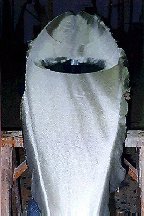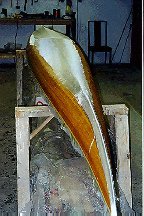
 |
||||
| INDEX | next
|
 |
The
inside deck is pasted from three leftover pieces of fabric, the compromise being money saved versus
ease of work. My rule of thumb about this is to always use one piece of fabric on the outside of the kayak and leftover pieces on the inside if necessary. The problem with using several pieces goes beyond the frustration over unraveling edges. The main issue is that you must overlap the sections (~2") without sanding them down. Nobody will see it on the inside of the kayak but it would look unacceptable on the outside. |
 |
Bias
cut cloth provides further reinforcement to the keel line and the stems. Again, it is made of several
segments. Sanding through overlaps in this abrasion patch poses no threat to the integrity of the underlying main cloth cover. In fact, the overlaps on the abrasion patch are important because when they get sanded down the surface will be fair. Butting the fabric together edge to edge will force you to fill the groove between the sections later. It just adds more unnecessary work. The stern keel of single kayaks can be protected with an additional layer of glass or 'abrasion resistant fabric' because it is subject to more abuse during launching. |
| INDEX |
| Home | Kayak Designs | Kayak Shop | Materials | Kayak Gallery | About us |
| Building Manual | Plans | Sandwich Core | Wood Kayak | Order | |
| Epoxy Test | Abrasion Cloth | Rudder | Resources | Choosing Kayak | Guestbook |
If you notice any problems with the site (i.e. error links, missing images) please, let me know. Thanks
Mail:
Vaclav Stejskal
10 Colonial Court apt. 73
Stoneham, MA. 02180
USA
Tel: 781-481-9261
© 1999
- 2020 Copyright Vaclav Stejskal
All rights reserved
Last page update:
11 January 2020